
Insulation plays a pivotal role in your home’s efficiency, significantly impacting energy conservation, and more importantly—how comfortable you are in your own house. Insulation is much more than just the “itchy pink stuff in your attic.” So let’s talk about a variety of insulation materials available, their appropriate applications, and how they can benefit you.
Types of Insulation
Fiberglass
Fiberglass is one of the most common types of insulation materials and is ideal for attics, walls, and floors. It comes in batting (sheets), rolls, or loose. It works as a good thermal and acoustic barrier, and is fireproof. It’s cost-effective and suits large-scale applications, but has to be installed without compression, otherwise its effectiveness becomes limited. Fiberglass insulation is also slightly less susceptible to mold and mildew than cellulose insulation, but is less environmentally friendly.
Cellulose
Best for retrofitting existing structures, cellulose can be blown into walls or attics. It’s an ecofriendly solution that effectively reduces air infiltration. It is a greater investment than fiberglass insulation, but is better at blocking air, and provides better soundproofing. Its susceptibility to mold comes from its ability to absorb moisture, so if you’re planning to use cellulose in your attic, you definitely want to make sure you have adequate roof ventilation.
Spray Foam
Spray foam excels in sealing air leaks and insulating irregular spaces. It comes in two types: open-cell, which is permeable to moisture and suited for interior use, and closed-cell, which is denser, moisture-resistant, and used in both interiors and exteriors for added structural strength. Spray foam is fantastic for filling gaps, cracks, and small spaces where air would normally seep through.
It’s highly recommended that you don’t use it for anything other than sealing gaps unless you really know what you are doing. Don’t get the idea that spray foam is just what you need everywhere. That could cause big problems! If you don’t have an HVAC system designed for a spray foamed house, don’t spray foam your house. Similarly, if you don’t have a conditioned attic space, don’t spray foam your attic.
Rigid Foam Board
Used primarily in basement walls, under floors, and on flat roofs, rigid foam board provides high insulation values and excellent water resistance, making it ideal for moisture-prone areas. This kind of product can also be used under basement slabs, due to its structural capabilities, and behind siding on the exterior of your home, to stop thermal bridging (weak points that allow heat to pass through more easily).
Mineral Wool
Because of its superior fire resistance and soundproofing capabilities, mineral wool is perfect for commercial buildings, fire stops, and high-temperature areas. Its density also helps with sound reduction between spaces.
Reflective Insulation
Radiant barriers are typically most effective in hot climates. This type of insulation helps keep spaces cooler by reflecting radiant heat. It’s most commonly installed in attics or behind siding to improve a building’s cooling efficiency. This is another tricky product though. Like spray foam, before using this product you’ll want to dig into the specifics of your home, and how it was designed to be insulated.
Are You Paying High Energy Bills, Yet Your Home Is Uncomfortable?
The vast majority of houses in this area were built with average building methods at best. Many homes were built with builder’s-grade windows, uninsulated vinyl siding, and roofs with inadequate ventilation—all of which our Presidential Exteriors crew are happy to help repair or replace. But they were also built at a time when the code didn’t require much in the way of attic insulation.
If your attic looks like the above pictures, then you are probably paying too much on your energy bills and you likely aren’t comfortable in your own home. A good way to tell if your home isn’t well insulated is to feel the difference in temperature between floors (and sometimes even between rooms in your house). While this could be due to problems with your HVAC, often it’s because your HVAC can’t keep up with how rapidly the indoor air is seeping right out of your house.
The sooner you get your insulation taken care of, the sooner you start saving money on electric bills, and the more comfortable you’re going to be in your house. The best time to improve your insulation is when you buy a home. The second-best time is today.
How Presidential Exteriors Insulates Homes for Optimal Results
Sometimes to know what something is, you’ve got to know what it’s not. If your home is uncomfortable, at Presidential Exteriors, we’re not filling entire cavities of it with spray foam. The first thing we do is move all of your old insulation out of the way, and air seal everywhere that air is currently easily seeping through. This includes top plates (the beam on top of the walls that supports your roof structure), penetrations for plumbing, ducting, electrical wiring, cabinet soffits, and more. We also install shielded and insulated boxes for your recessed lights and around any necessary junction boxes—using spray foam to plug everything up.
Next, we install baffles for ventilation to ensure your soffits can take in the air you need for your ridge vent to exhaust properly. We bring in some big tubes and bring your insulation up to code with a bunch of fresh, fluffy, hard-working cellulose insulation.
The goal is to have a well-ventilated attic and a well-sealed conditioned space. This ensures your roof lasts (without being cooked from the inside), and your HVAC lasts significantly longer because it’s working significantly less!
Enjoy a Comfortable Home Interior and Save on Utilities with Insulation by Presidential Exteriors
Don’t settle for subpar insulation in your home. Get the kind of insulation you need where your home needs it, installed by our team of experienced pros at Presidential Exteriors.
We’ve successfully completed over 15,000 home exterior projects throughout the VA and MD area. Let us help you find the insulation that is right for your home.